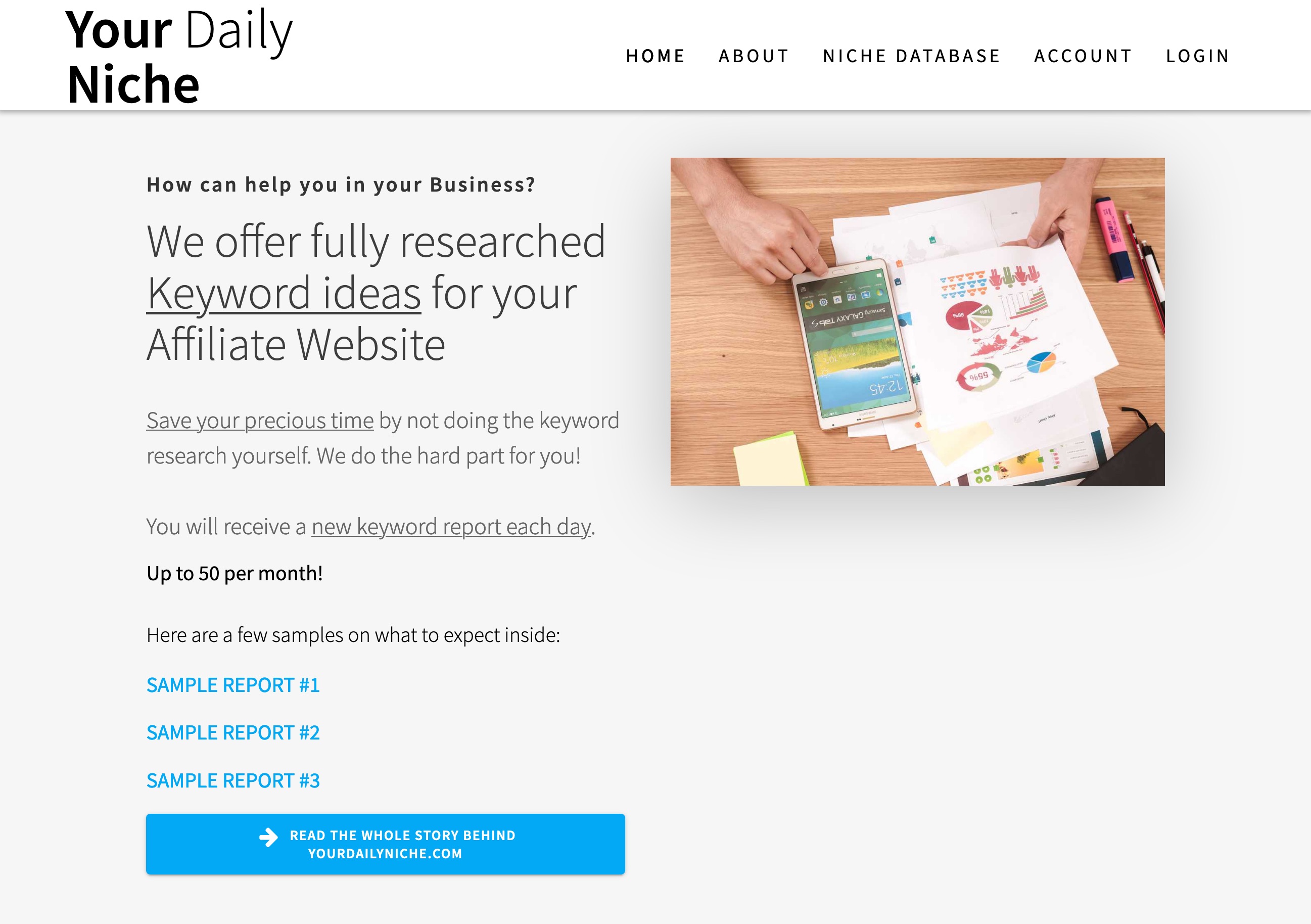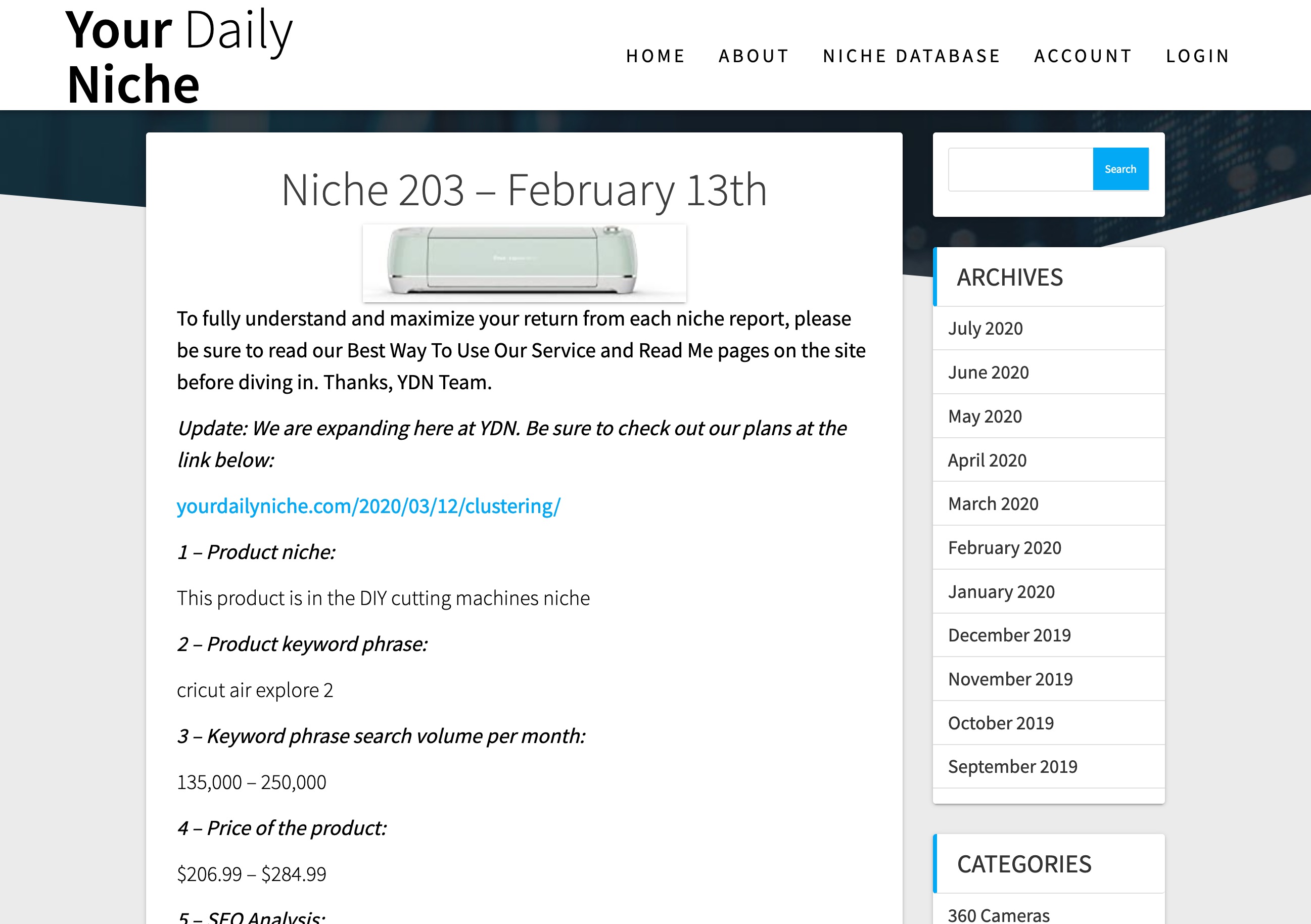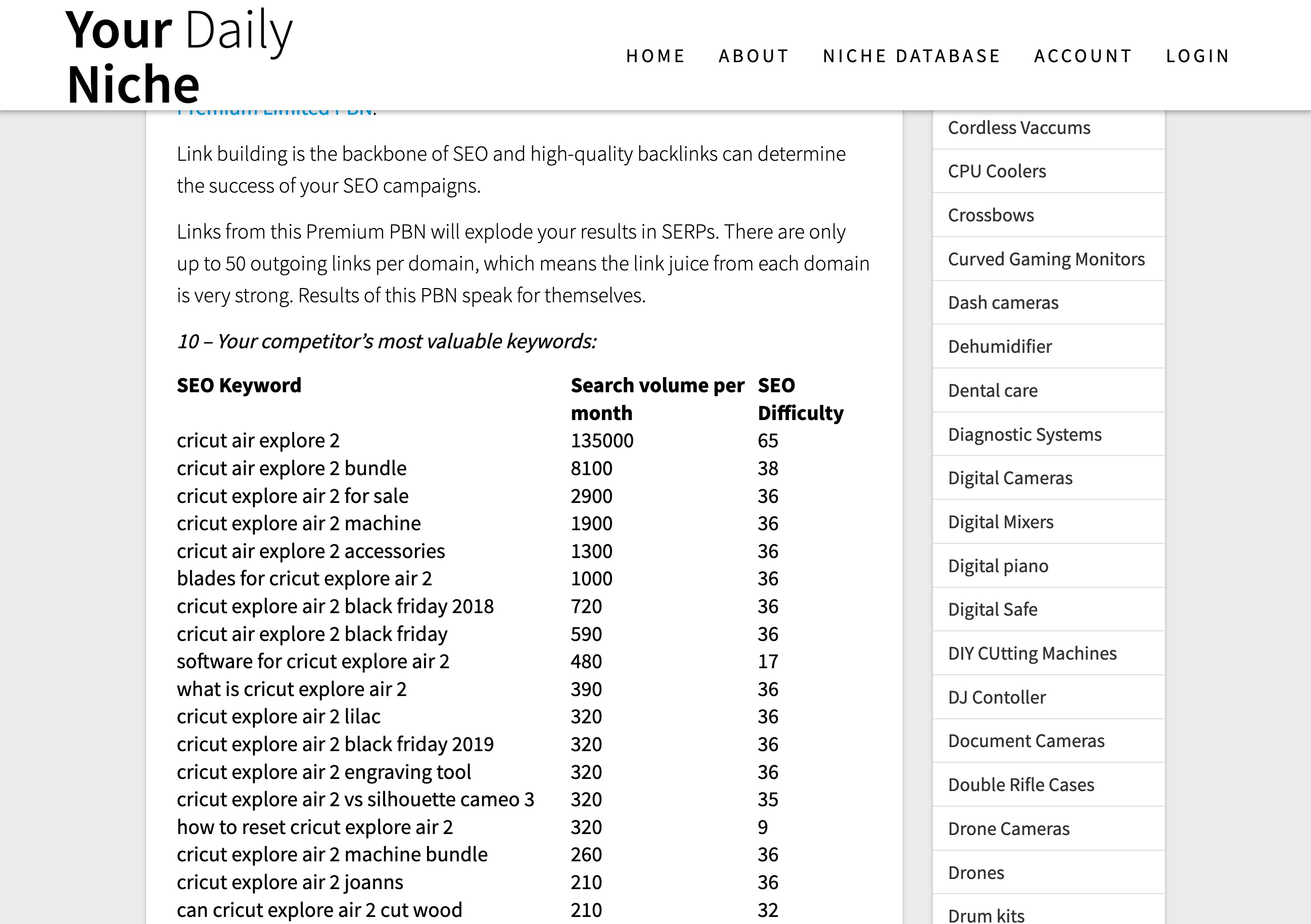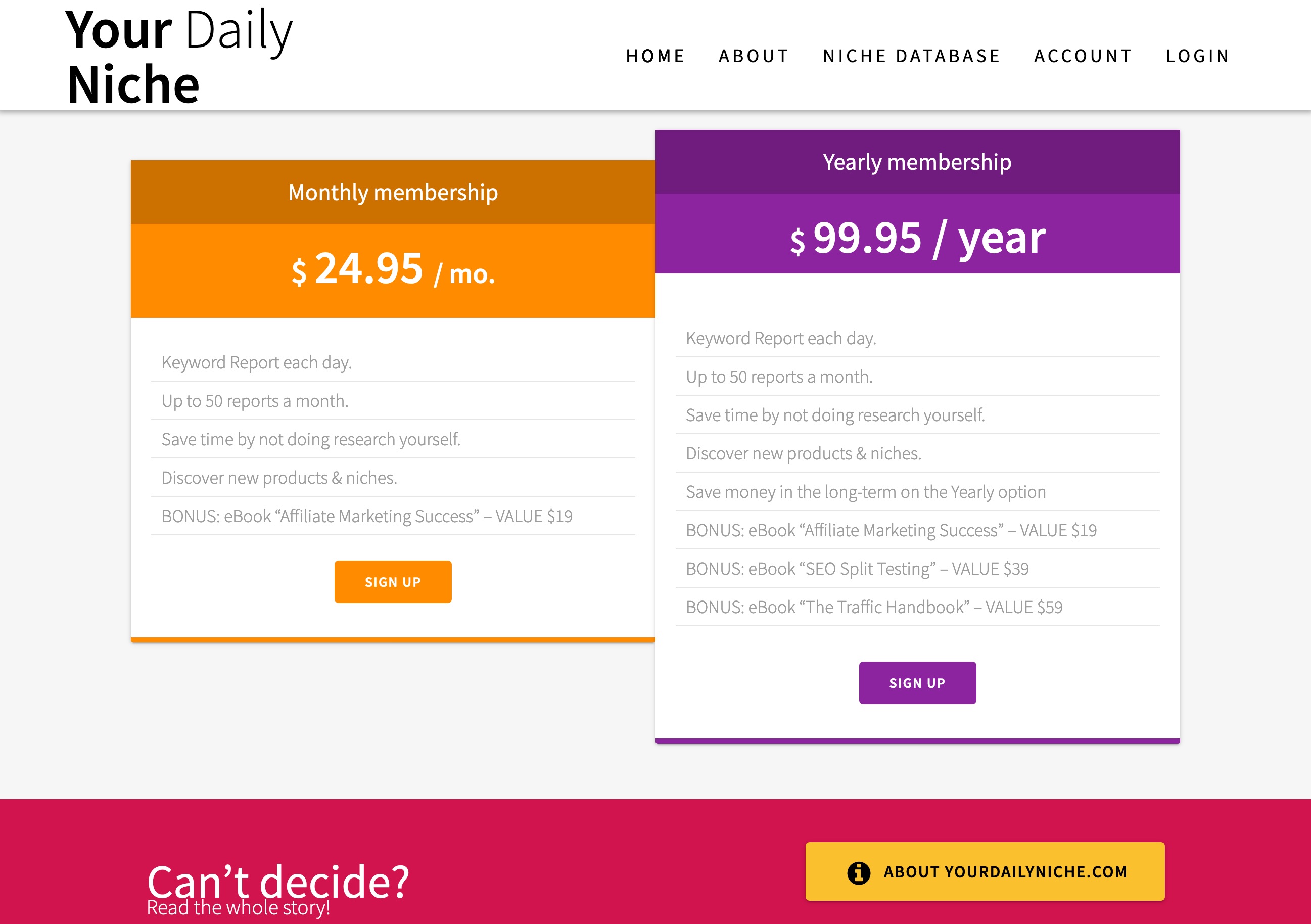Communicating Your Product When It's Hard to Explain
They say you need a website to be concise. Few words. Concentrate on what it does, show the benefits, make it quick.
But you’ve tried concise. You’ve tried to make it quick, and your site isn’t communicating the product like it needs to. You’re suspecting people are leaving because they don’t understand your product, what it does and how it could help.
The trick is to quit trying to be concise-yet-widely-understandable and instead go for obvious-to-those-with-the-struggle.
Let’s take an example.
Here’s yourdailyniche.com, a site selling a membership where you get an example niche each day.
Some questions come up:
- What’s a niche?
- What’s affiliate marketing?
- What’s a keyword report?
“Keyword Ideas”, that’s interesting. What’s an Affiliate Website?
Let’s look at a sample report…
And scrolling down, we get to more keyword ideas…
And back on the home page, here’s the pricing…
The author of this site (Martins) asked for some feedback on IndieHackers about his product.
How can we make the site better at explaining the product? Martins shares that it’s not selling enough and wonders if it’s because visitors don’t get it.
How the Current Page Explains the Product
The page uses a mix of approaches:
- explaining the benefits (“Save precious time”),
- detailing what you’ll get (“Keyword Ideas”, “Daily Keyword Reports”), and
- hinting at the visitor’s problem (“You need a product that will actually sell”)
Some people in the thread offer to write some more clever headings. That’s still about trying to go for the concise-yet-widely-understandable. I don’t think that’ll do it, not for this product.
There is a way to better explain this product, and I’ll bet it’ll help to downplay the affiliate marketing angle.
Understanding (A Couple) Visitor Perspectives
When we pretend we’re a visitor, does the site work?
To answer that question, let’s run through the site using the lens of the Forces of Progress, those forces that build up in/recede from the mind of the buyer as they scroll down the page.
If the top two forces are stronger than the bottom two forces, you’ve got a sale.
Does every visitor experience the site the same way? No, but most visitors will come with a common set of struggles, attractions, anxieties and fallback habits.
In particular, there will likely be a few key struggles prompting the visitors to get moving, bringing them to the site. So let’s check out two likely struggles, and map out the rest of the forces in reaction to those struggles.
Struggle #1:
I’ve been doing my own keyword research and can’t find anything that’s good enough
This is essentially the struggle around which the site is currently built. Does it work?
“When” Statement:
When I’ve been doing my own keyword research and can’t find anything that’s good enough, I want to look for blogs or other sources that highlight hot markets So I can get my first sale.
- ⚬→ Struggle: I’ve been doing my own keyword research and can’t find anything that’s good enough.
- →⚬ Attraction: There’s a good variety of new keyword ideas.
- ←⚬ Anxiety: There’s probably a lot of people subscribed to this list, competing against me.
- ←⚬ Anxiety: How do I know if these keyword reports are any good?
- ⚬← Habits: I’ll just continue searching for something unique, on my own.
As you can see, these folks will likely leave, despite the fact they already understand what affiliate marketing means. It hinges completely on the quality of the product/keyword, and cynicism might be high on what’s on offer. They’re looking for exclusivity + quality. Plus, their “I’ll just” statement is pulling strongly back toward a “Not this, not now”.
Other note: This search for exclusivity + quality (for people experiencing this situation) creates a strong interest in not telling the world about this site. This hurts word-of-mouth.
So trying to serve this struggle won’t pay off, neither for the buyer, nor for the product owner.
- We can confidently downgrade our efforts to serve this struggle.
- This is not a situation we need to explain our product to.
Struggle #2:
I’ve just lost a job and I need some revenue
This one is broader, but closer to the core struggle, and I bet it’ll help explain the product better (we’ll do that next).
“When” Statement:
When I’ve just lost a job and I need some revenue, I want to look for blogs or other sources that highlight hot markets So I can get some inspiration and maybe get my first sale.
Here we see a lowered aspiration. The stakes should be higher (losing a job), but instead, this person is likely coupling this side-hustle with some freelance work. The focus is more on learning, starting small, and making small bets.
Let’s look at the forces:
- ⚬→ Struggle: I’ve just lost a job and I need some revenue.
- →⚬ Attraction: There’s a good variety of new keyword ideas.
- →⚬ Attraction: I’ll be able to get some practice in.
- →⚬ Attraction: I’ll be able to learn a few things, including this whole affiliate marketing thing.
- →⚬ Attraction: This is affordable. I can offset this from my feelance revenue.
- →⚬ Attraction: I can experiment at my own pace. The daily email will keep me on my toes.
- ⚬← Habits: I’ll think on it a couple days.
In this case, no significant anxiety, lots of attraction, no big “I’ll just” habits either. We’ve got a winner here. So how can this new understanding help communicate what the product is and does?
Changing How the Site Explains the Product
I’d start the page with a short description of what it is, followed quickly by a retelling of the visitor’s struggle.
Your Daily Niche
A daily report sent to you with a niche you can use to, for example, build an affiliate website (I’ll come back to that further down).
You have been trying to find a niche ASAP.
Yes, a niche, a small-yet-big market. Small enough to be precise and easy to target, but big enough so you can get some revenue even if you serve a fraction of it.
- Maybe you’ve just got canned and you need a new source of revenue
- Maybe you’ve been trying to find a product of your own
- Maybe you’re hoping this is the month you’ll make your first real sale
Each day, I’ll send you one or more reports on a niche I find. It features a product that’s in demand, the keywords people are typing in search, and steps on finding these people…
What should you do with one of these reports?
I’d build a website and drive people to the product opportunity, so they can buy that thing and you get a cut. That’s what’s called an affiliate website. And here’s how you can drive people to your affiliate website:
Steps…
Something like that.
We can confidently write conversational sentences (or whatever writing style you choose) because we understand the key struggle for which this product will be a home-run. Everything else flows from that understanding.
Explaining the product is now easy-peasy. No need to try to be concise-yet-widely-understandable. You now have what you need to be obvious-to-those-with-the-struggle.
Stay Sharp!
—
Pascal Laliberté
@pascallaliberte





